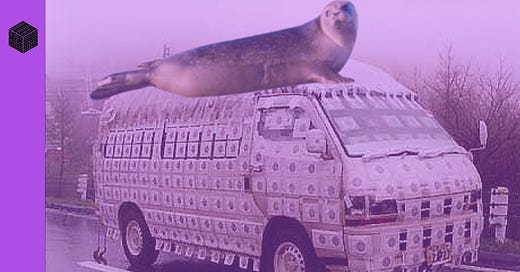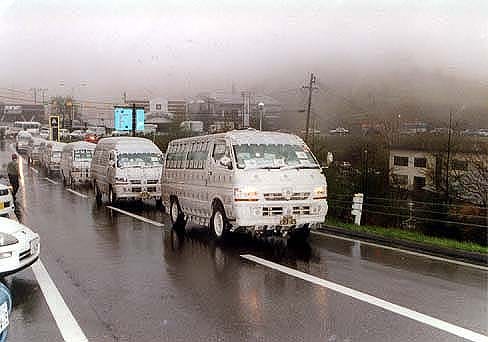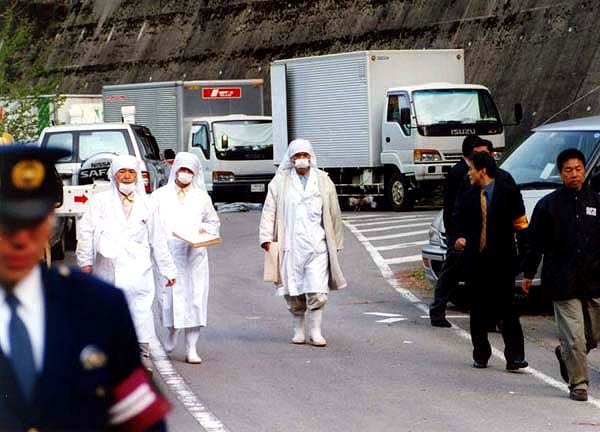⛩️ #24 A Doomsday Cult Tried Rescuing a Lost Seal
The Headlines, This Week in Japanese History, and Much More
Welcome back! Today’s edition of The Kyote is for you if ever wanted to know about:
Doomsday cults rescuing lost arctic seals
Napoleon Bonaparte’s subway pass
An interview with million-selling author Bill Adler
& which episodes of Pokemon featured blackface, gargantuan breasts and epilepsy
Let’s get into it:
Impossible is a word to be found only in the dictionary of fools.
Napoleon
Impossible may not be in Napoleon’s dictionary, but 定期券, meaning “commuter pass” is — in this 1978 poster encouraging Tokyo commuters to clearly show their passes as they go through the ticket gates.
THE QUIZ
A picture that Japanese people will recognize instantly. Do you?
Question: what’s going on here?
Answer at the foot of the mail.
THE MONEY
$1 = ¥146
[😬]
THE HISTORY
A DOOMSDAY CULT TRIED RESCUING A LOST SEAL
Pana-Wave Laboratory cult trucks (complete with “scalar electromagnetic wave protection”. Source: http://teamkokudo.org/genba/jiken/pana/pana.htm
When aquatic mammals get lost and swim into city rivers, human beings tend to lose their shit.
In 2018 a Beluga whale blundered up the Thames into London and became a sensation. Benny, as the wayward cetacean was dubbed, just wanted to muck around amongst the barges and nosh fish, but managed to become an accidental livestreamed media God — as millions of people participated in their own irony by focusing their attention on an animal while simultaneously hoping that animal would just, please, be left alone.
The British are not uniquely dumb in this regard.
What is unique are the finer details of such human-animal encounters — and they turn out to give illuminating insights into a culture.
Take the names these animals are branded with — can the huckster spirit be better illuminated than the escaped Californian sea lion dubbed Slippery?
Or the instant recourse to the po-faced that accompanied another Beluga whale found in shallow waters, Germany’s Moby-Dick? Next to this, the British “Benny” shows its parochial, faintly ridiculous nature, which is not the worst way to describe that entire nation.
Then there’s Tama-chan, the bearded seal who appeared in Tokyo in the summer of 2002. “Tama” (from the river in which he was first spotted) lacks imagination, even if it is pleasingly euphonious, but that chan is key — the diminutive suffix usually reserved for young girls, dolls and the endearing, it speaks to a pathological need to cutify at first sight.
* * *
The very best thing about these lost animals is how they don’t care a jot about the people who are weepingly concerned for their welfare.
Tama-chan, who should, by species, have been freezing his nuts off somewhere in the arctic, was instead having a merry old time in the brutal Tokyo summer.
And as this jolly lad enjoyed his extended summer vacation, Japanese culture came to life:
First the crowds arrived — cameras mandatory
Then came the merchandise, with Tama-chan, the bearded seal who can actually be a vicious bastard of a thing, reduced to a smiling caricature
Then the whole event was not organized enough, so the official fan clubs began; those maniac people who crave the certainly of membership lists and weekly mail-outs and bylaws dragging other Tama-chan fans into their orbits
Closely followed by the inevitable official co-opting of attention: the Yokohama government (into whose Tsurumi River Tama-chan had migrated) deciding to give the seal honorary residence of the city.
(In a country where cartoon characters are granted official citizenship but refugees are not, a bunch of foreign nationals staged a march with whiskers drawn on their faces to demand the same right that had been extended to Tama-chan.)
None of the above will be a surprise to anyone even vaguely familiar with Japan, but what happened next was rather more lurid: the doomsday cult de jour arrived on the scene.
* * *
Pana-Wave Laboratory geeks in their fishmonger-meets-nurse garb. Source: http://teamkokudo.org/genba/jiken/pana/pana.htm
Pana-Wave Laboratory is a brilliant name for a nutcase organization because it puts the psuedo-science right up front, appealing to the kind of person who knows, in theory, that the world is governed by the laws of physics, but thinks it impossible that those laws could fail to take into account how special they are.
The particular bullshit Pana-Wave peddled has become somewhat of a growing market in the years since: electro-magnetic waves are f*cking up your health. Big Comms knows this and is covering it up. Life should be spent deep in a forest without cellphone service. Headgear made from shiny metal helps also.
Pana-Wave was the intelligent offshoot from a cult named Chino-Shoho (“The True Law of Chino”). Guess what the name of the leader was. Yes, Chino.
In the manner of all Japanese cult leaders, this maniac woman took the freakiest parts of Christianity, Buddhism and New Age and glued them together with cult of personality. She also got cancer, which was caused, obviously, by fiendish Communists beaming “scalar electromagnetic rays” in her general direction.
This, the Communist ray-bombardment, was a world-level crisis because Chino’s death would bring about the instant and total extinction of the human race.
Now, this didn’t have anything to do with Tama-chan, a seal living his best life in Japan’s rivers, and who, if anything, would probably be delighted to see the bipeds who steal most of the fish permanently wiped out.
Except Pana-Wave’s great leader understood that Tama-chan had, in fact, been led astray by the same electromagnetic waves that had ruined her health, and mobilized her gang to save the seal.
First step was building two swimming pools, lined in their brand color of white, in a compound in Yamanashi Prefecture in which Tama-chan would be kept until he could be transferred back to the Arctic (by unspecified means).
An armada of trucks, covered in plaster into which swirly protection symbols had been molded, set off on this desperate rescue trip.
Unfortunately, the Pana-Wave morons had spent too much time on book work and not enough on fishing practice, and Tama-chan slipped through the nets they deployed (we like to think he laughed and extended the seal equivalent of a stiff middle finger).
As Pana-Wave jumped in their trucks and pissed off again, Japanese officialdom did what they do, and plastered the riverbank with signs and security cameras to make sure there was no repeat.
Failure never getting in the way of a good cult-boss, Chino switched to a more dramatic presentation: a close encounter with an undiscovered 10th planet, predicted for 15 May that year, would cause the Earth's poles to flip over and lead to catastrophic earthquakes and tsunamis which would destroy most of humankind. Pana-Wave was now going mobile, looking for a safe location to ride out the catastrophe.
Their white van convoy took a circuitous and highly photogenic route around a rural Japan freaked out by the Aum Shinrikyo subway massacre, while riot police and TV crews followed to keep tabs on their activities.
Japanese police loving a minor offense they can over-react to, on 14 May, the day before the predicted doomsday, police raided twelve locations associated with the group on the pretext of minor vehicle registration offences. However, nothing was found which suggested that they posed a danger to society — and when the May 15 doomsday passed with nothing more serious than a minor earthquake in Tokyo, a member thought to be Chino's second-in-command made a statement that they believed that they had miscalculated the date, and a new annihilation countdown to May 22 began.
You won’t be surprised to discover this date too passed without world-ending incident, and the media attention faded and the group sank back into obscurity.
On 25 October 2006, cult mastermind Chino died at aged 72.
The last sighting of Tama-chan was in the Arakawa River on April 12, 2004.
THE INTERVIEW
“I will be in Japan forever because the woman I love is here.”
Bill Adler is an American writer living in Japan. His books have sold over a million copies.
Live now:
Kawasaki
Passport?
United States of America
Arrived in Japan
After ten trips back and forth between Washington, DC and Tokyo, I moved to Japan in 2014. That commute is hellish.
Favorite place
Karuizawa. It’s a pretty city, fun to bicycle in, and is easy to get to from Kawasaki—one hour on the Shinkansen.
Favorite word
Daijoubu (大丈夫) because it does everything.
Natto, yay or nay?
If I never ate natto again, I wouldn’t miss it.
Most embarrassing moment
Our local bakery has two metal trays at the counter, one for food, the other for money. I put my money on the food tray, and I’m sure they cremated the tray afterward.
Weirdest question from a Japanese person
I can’t say that I’ve ever been asked a weird question from a Japanese person.
Ever sang A Cruel Angel’s Thesis?
I haven’t but I like J-Pop!
Experienced a Japanese funeral?
No, but I have been to my girlfriend's grandparents’ grave.
Japan forever?
I will be in Japan forever because the woman I love is here.
Bill Alder writes Fiction by Bill Adler and Stray Cats of Japan
THE LANGUAGE
5 Japanese Companies Named After English Abbreviations
Explanation
UNIQLO
The first Unique Clothing Warehouse store was, obviously, shortened to UNICLO. Unfortunately (or fortunately, considering its subsequent success), some doofus misspelled the name as UNIQLO on the founding documents of the Hong Kong subsidiary — before CEO Tadashi Yanai declared it better than the original.
DOCOMO
Ubiquitous mobile phone and Internet operator whose name is a homonym of “dokomo” (everywhere), the official story is an abbreviation of the slightly wonked-out English phrase “Do Communications Over the Mobile Network”.
CALPIS
Manufacturer of the milky soft drink of the same name, the company’s moniker is a combination of cal as in calcium plus the latter half of the sanskrit word sarupisu, meaning “best taste”. Calpis remains an awful name for a drink that tastes like it might be cow piss; it’s marketed as “Calpico” outside Japan.
MOS Burger
Popular fast food chain MOS probably got its name from some utilitarian nonsense like Manufacturing On-Site, right?
Actually, it’s the oddly-sweet Mountain Ocean Sun.
AIFUL
Affection, Improvement, Faithfulness, Unity, Liveliness.
So, what type of company is AIFUL? Why, a consumer loans company that has been sanctioned for predatory lending of course! Hey, at least they have a sense of humor…
THE LINKS
3 things worth your time from this week:
Massive boobs, epilepsy and blackface: a rundown on banned episodes of the Pokemon cartoon
What everyone in Japan should prepare in case of a catastrophic earthquake
A crying Olympic judoka faces criticism for insufficiently accepting defeat
THE ANSWER
Question: what’s going on here?
Answer: the average experience for visitors to Nara Park, where packs of cute aggressive deer beg for extort rice crackers from tourists.
Enjoy The Kyote this time? Check this out next: The Gruesome Deaths that Inspired the Movie Godzilla
We’ll see each other again next week,
The Kyote
Comment? Just Hit Reply
The Kyote is published in Kyoto, Japan every Sunday at 19:00 JST

















Thanks for the links and back-story about Uniqlo.
Terrific!